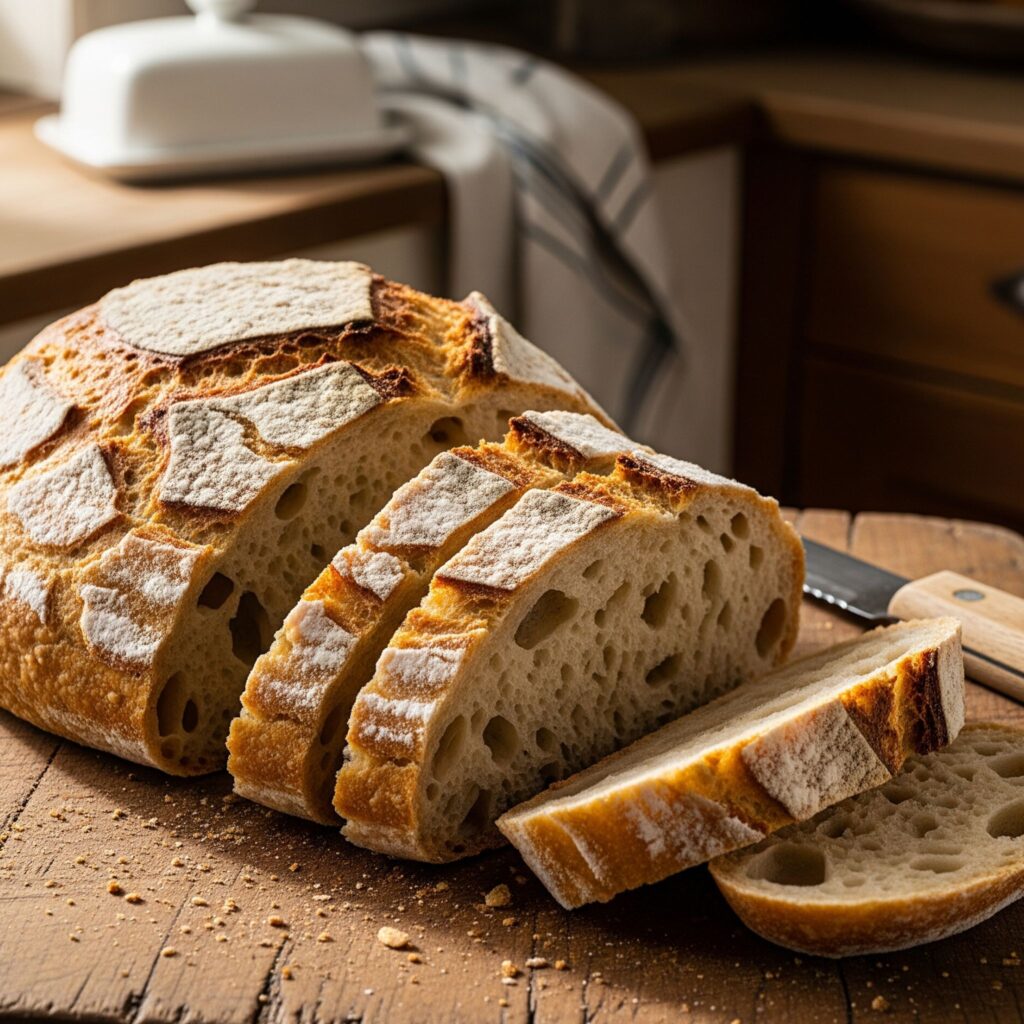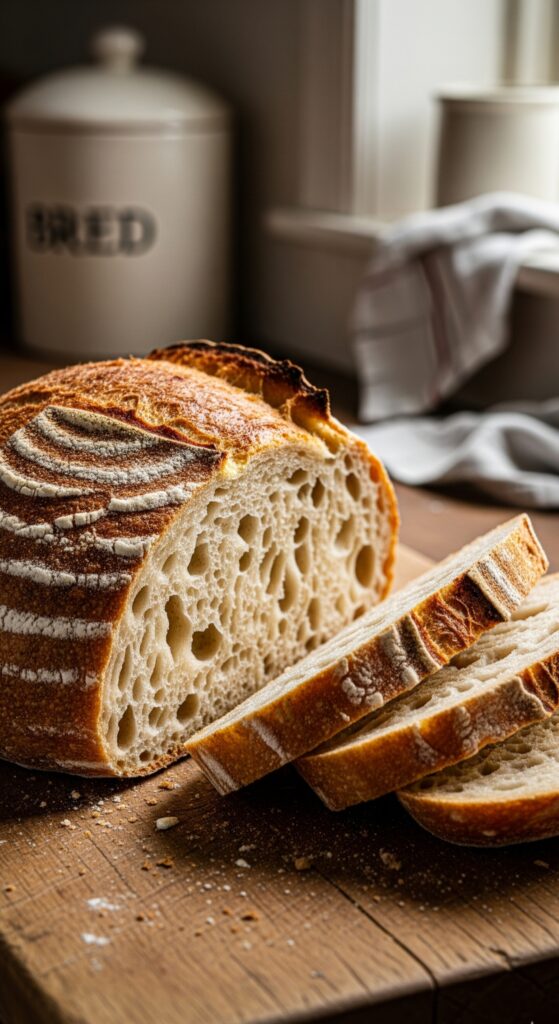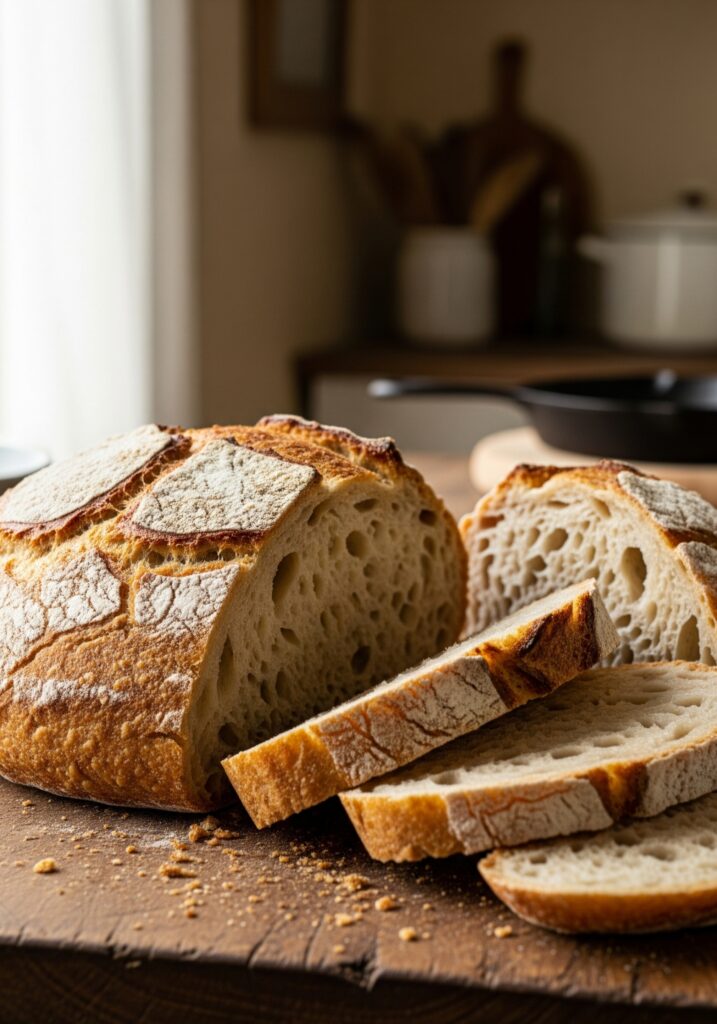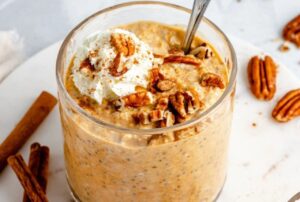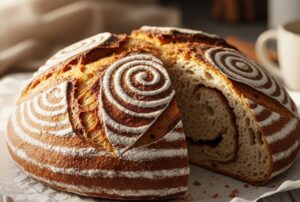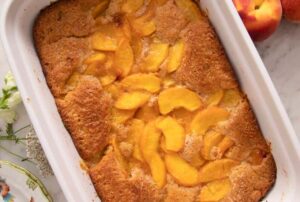So, you want to bake gluten free sourdough bread? Great choice, my friend. Honestly, nothing beats the smell of fresh bread straight out of the oven, and when it’s sourdough, it feels like you’ve somehow tapped into ancient baking magic. But if you’re avoiding gluten (whether it’s celiac disease, an intolerance, or just personal choice), the regular stuff isn’t gonna cut it. That’s where this recipe swoops in like a carb-filled superhero.
And before you ask—yes, you can make sourdough bread without gluten. And no, it won’t taste like cardboard (well, not if you do it right 😉). I’ve been experimenting with gluten free baking for years, and let me tell you—once you nail the starter and learn how to handle the dough, it’s seriously game-changing.
Let’s break it down step by step so you can bake a loaf you’ll actually brag about.
Why Gluten Free Sourdough is Worth It
First things first, why should you even bother with gluten free sourdough bread?
Because unlike regular gluten free bread (which sometimes tastes like dense sponge), sourdough has that tangy flavor, chewy texture, and crunchy crust we all crave. Plus, the natural fermentation process makes it easier to digest. Ever felt like gluten free bread just… sits in your stomach like a brick? Yeah, sourdough fixes that.
Also, there’s the satisfaction of keeping a sourdough starter alive. It’s basically like having a pet you can eat. Sounds weird, but once you start feeding it daily, you’ll understand.
The Starter: Your Bread’s Secret Weapon
The first thing you need is a gluten free sourdough starter. Without it, you’re basically making sad flatbread.
How to Make a Gluten Free Starter
- Day 1: Mix ½ cup of brown rice flour (or sorghum flour) with ½ cup of filtered water in a glass jar. Stir well.
- Day 2–7: Feed it every 24 hours with the same amount of flour and water. Stir, cover loosely, and let it sit at room temperature.
After about a week, you should see bubbles and smell a tangy aroma. That’s your starter saying, “Hey, I’m alive!” If it smells like something died in there—sorry, start over.
Pro tip: Brown rice flour makes a reliable starter, but you can also use buckwheat or millet. Don’t even think about using almond or coconut flour—they’re too oily and will kill your starter.
The Recipe: Gluten Free Sourdough Bread
Okay, let’s get to the good stuff—the actual bread. This recipe makes one medium loaf, perfect for sandwiches, toast, or just ripping apart with your hands like a savage (no judgment).
Ingredients You’ll Need
- 1 ½ cups active gluten free sourdough starter
- 2 cups gluten free all-purpose flour (make sure it has xanthan gum)
- 1 cup brown rice flour
- ½ cup tapioca starch
- 2 tsp salt
- 2 tbsp olive oil
- 1 ½ cups warm water (adjust as needed)
Step-by-Step Instructions
- Feed your starter. Make sure it’s bubbly and active before baking. If it’s been chilling in the fridge, wake it up with a couple of feedings.
- Mix dry ingredients. In a large bowl, combine the all-purpose flour, brown rice flour, tapioca starch, and salt.
- Add wet ingredients. Stir in the starter, olive oil, and water. The dough will look more like thick batter than traditional bread dough. Don’t panic—that’s normal.
- Let it rest. Cover the bowl with a towel and let the dough rise for 4–6 hours at room temperature. It should puff up a bit, but don’t expect it to double in size like wheat bread.
- Shape it (sort of). Transfer the dough to a greased loaf pan. Smooth the top with a wet spatula because, again, this isn’t your usual knead-and-shape situation.
- Second rise. Let the dough rest for another 30–45 minutes.
- Bake. Preheat your oven to 425°F (220°C). Bake for 45–55 minutes until the crust is golden and it sounds hollow when tapped.
- Cool before slicing. I know it’s torture, but cutting too soon makes it gummy.
And boom—you’ve got yourself a loaf of gluten free sourdough bread that actually tastes like real bread.
Tips for Success
Now, let me save you from the rookie mistakes I made (so you don’t cry over weirdly dense loaves).
Don’t Skimp on Hydration
Gluten free flours need more water than wheat. If your dough looks dry, add extra water a tablespoon at a time. Too much? You’ll get mush. Too little? Dry, crumbly sadness.
Use a Kitchen Scale
Seriously, weighing ingredients is a game-changer. Cups are fine for pancakes, but for bread? Accuracy matters.
Patience is Key
Gluten free sourdough rises slower. If you’re staring at it after two hours thinking, “Why isn’t this moving?”—relax. Give it time.
Store It Right
Gluten free bread dries out quickly. Wrap it in a towel and keep it in a bread box for 1–2 days. For longer storage, slice and freeze it. You can pop slices straight into the toaster.
Variations to Try
Bored of plain bread? Let’s spice things up.
- Seeded Loaf: Add sunflower, sesame, or pumpkin seeds. Makes the crust extra crunchy.
- Herb Bread: Mix in dried rosemary, thyme, or garlic powder for flavor that’ll make your house smell amazing.
- Sweet Twist: Add a touch of cinnamon and raisins. Breakfast = sorted.
Ever tried toasting gluten free sourdough with butter and honey? Trust me, it’s next-level.
Why This Recipe Works
I’ve tested a bunch of versions, and this one hits the sweet spot:
- Brown rice flour gives it body.
- Tapioca starch adds chewiness.
- Gluten free all-purpose flour keeps things balanced.
Together, they create a loaf that’s not dense, not crumbly, and definitely not sad. IMO, it’s the closest thing you’ll get to bakery-style sourdough at home—without the gluten hangover.
Common Questions
Can I skip the xanthan gum?
Nope. It acts like gluten’s replacement and helps the bread hold together. Without it, your loaf will collapse.
Can I use a bread machine?
Sure, but you’ll lose that rustic crust. Personally, I like the oven method—it feels more authentic.
Do I really need a starter?
Yes. Otherwise, you’re just making yeast bread. Which is fine, but then don’t call it sourdough.
Final Thoughts
So there you have it—a gluten free sourdough bread recipe that’s actually worth your time. It’s chewy, tangy, and makes the perfect base for anything from avocado toast to grilled cheese. Honestly, once you get the hang of it, you’ll never look at store-bought gluten free bread the same way again.
Remember: keep your starter happy, stay patient during rises, and don’t cut into your bread too soon (I know, the struggle is real).
Give this recipe a try, and you’ll see why I call it my go-to. And hey, if your first loaf turns out a little funky, just call it “rustic” and pretend that was the plan all along. 🙂


